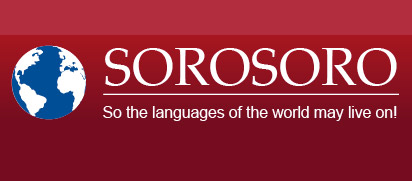Print  |
|


Zamucoan languages
Data about Zamucoan languages
Where are spoken these languages ?
They are spoken in the Chaco Boreal, in South-East Bolivia and in Northern Paraguay.
Who does speak these languages ?
They are spoken by indigenous people who have been living in the area for a long time, definitely before the European colonization. They possibly moved there from the Amazonian region.
Number of speakers :
5570 according to the site Ethnologue (http://www.ethnologue.com/)
6100 according to Fabre 2007
Classification
Apart from Chome’s Zamuco (extinct), the Zamucoan family consists of two living languages.
Ayoreo : 3770 according to Ethnologue
4500 ca. according to Fabre 2007 and Combès 2009.
Other names traditionally attributed to this language, to the extent that exactly this ethnic group was actually referred to in all cases: Moro, Morotoco, Samococio, Takrat, Coroino, Potureros, Guarañoca, Yanaigua, Tsirákua, Pyeta Yovai (see Fabre 2007, Combès 2009 and Ethnologue)
Chamacoco : 1800 according to Ethnologue
1600 ca. according to Fabre 2007.
Other names for this language (see the caution above): Ishiro, Jeywo, Yshyro (see Ethnologue)
main dialects: ebitoso,tomaraho
For further details about the linguistic classification, see Fabre 2007 (cited in sources) and the Ethnologue site. About uncertainties on many of the above-mentioned ethnic names, see Combès 2009.
Commentary about classification of Zamucoan languages :
Both Ayoreo and Chamacoco derive from a common ancestor, Zamuco, not to be confused with Chome’s Zamuco, described by the Jesuit missionary Ignace Chomé in the first half of the XVIII century. Chomé is the author of the remarkable grammar Arte de la lengua zamuca. Although Ayoreo and Chamacoco share no more than 30% of their lexicon, there is morphological and typological evidence accounting for this classification (see Bertinetto 2009, Ciucci 2009). Chome’s Zamuco, spoken in the Jesuit reduction of S. Ignacio de Samucos (see later), should be considered an archaic form of Ayoreo according to Kelm 1964. The two languages share most of the lexicon; it is however impossible to ascertain whether Ayoreo directly derives from Chome’s Zamuco or from one of its cognate languages, possibly one of the dialects named by the Jesuits during the XVIII century (i. e. caipotorade, morotoco, ugaraño according to Hervas 1784). There is a general consensus about the division of Chamacoco into two dialects, ebitoso and tomaraho. The majority of Chamacocos speak ebitoso, the tomaraho dialect is spoken by a small group of people (103 according to Fabre 2007).
Are these languages endangered ?
They are considered endangered by UNESCO (see Crevels & Adelaar 2000/06). In fact, although nowadays all Ayoreo are fluent in their language and, likewise, most Chamacoco (according to Fabre 2007) speak their language at home, in both communities many elements of their culture begin to be poorly understood by middle-aged people and bilingualism is increasing. It is forseeable that this will lead to some form of romanization of Zamucoan languages and possibly, in the course of a few generations, to their disappearance. Chamacoco (at least the Ebitoso dialect) seems to be more affected than Ayoreo by contact with the culturally dominant Castillan language, and to some extent also by Guaranì.
Ethnographic elements
The term ayoreo is the adaptation of an endoethnonim meaning ‘(real) person’ (ayorei m.sg); also the Chamacoco’s original name ɨshɨr means ‘person’. Ayoreo and Chamacoco form distinct ethnic groups. Both were contacted relatively late by the Western culture and at different times. The first contact with Zamucoan tribes was due to Jesuit missionaries, who established the mission of S. Ignacio de Samucos in the Bolivian Chaco in 1724. This gave Ignace Chomé the opportunity to describe their language. The named mission had a strong cultural influence on Zamucoan people, but obviously didn’t affect all Zamucos: according to Combès (2009), anthropological evidence referring to the Jesuit period can be found among the Ayoreos, but not among the Chamacocos. When the mission was abandoned in 1745, many individuals returned to their traditional way of life in the Northern Chaco savanna, while others remained inside (or in the proximity of) the Jesuit reductions in the Santa Cruz area, gradually adopting the language and culture of the dominant ethnic group, the Chiquitanos.
Before colonization, Ayoreos and Chamacocos lived a nomadic life: they were hunters-gatherers in a territory characterized by a hostile climate; their cultural and every-day life was deeply influenced by the strong contrast between abundant rain in summer and a dry season in winter: the latter one was a very difficult period which they had to adapt to in order to survive. The consequent and inevitable competition for natural resources led to hostile relations with all neighbors, even among one and the same ethnic group. War played thus a central role in their life. Both Ayoreos and Chamacocos are traditionally divided into seven clans with similar names. Their typical handicraft includes feather ornaments and products made by weaving the fiber of a plant called caraguatà, growing in the Chaco area (Fishermann 1988).
The Chamacoco culture was first described by the Italian painter-photographer-traveller Guido Boggiani (Boggiani 1894), while the final stable contact with the Ayoreos was due to evangelical missionaries at the end of the Forties. For further information, see Combès 2009.
Linguistics elements
All Zamucoan languages have trascription systems established by missionaries in different times. They are based on Castillan ortography. Ayoreo, as well as Chome’s Zamuco, has the five vowels /a e i o u/, while Chamacoco adds the high central vowel /ɨ/ typical of other languages of the area. Vowel nasality is a distinctive phonological feature in both languages. Another common morphophonological feature is nasal harmony, which especially manifests itself in affixation. Interestingly, both Ayoreo and Chamacoco present a series of unvoiced nasal consonants.
Zamucoan languages are fusional and their morphological structure is simple as compared with most surrounding languages, characterized by highly agglutinating structure. Nominals inflect for number (singular and plural) and gender (masculine and feminine); e.g., in Ayoreo the word ‘person’ is ayorei (m.sg), ayoreode (m.pl), ayoré (f.sg), ayoredie (f.pl). Ayoreo presents a systematic contrast between a ‘base’ and a ‘full’ form in nominal morphology. The ‘base’ form (which has a plural of its own) constitutes, in the singular, the source of any morphological operation (inflection, derivation, composition); in addition, it has its own syntactic functions. Chamacoco presents traces of the same divide between ‘base’ and ‘full’ form. An areal feature shared by Zamucoan languages is the possessive inflection of nouns, which are divided into possessable and non-possessable nouns: the former, whenever needed, take on the relevant possessive prefixes, while non-possessable nouns may require a dedicated classifier, as is the case in Ayoreo. The prototypical constituents order is SVO; however, in genitival construction, consisting of the mere juxtaposition of nominals, the determinant(s) precede(s) the determined element. Along with the presence of postpositions, this suggests that these languages have undergone a typological change.
Verbal morphology does not present any tense-inflection; temporal reference is expressed with the aid of adverbial elements. There is an Indicative and a Non-Indicative form; the latter carries modal meanings. This and other evidence lead to consider these languages as mood-prominent (see Bertinetto 2009). Verb declension is generally simple and regular. Strikingly, the morphological exceptions often have corrispondences in both Ayoreo and Chamacoco (v. Ciucci 2007/08, Ciucci 2009, Bertinetto 2009), suggesting a deep, if distant, relationship between these two languages. Chamacoco presents the areally common inclusive/exclusive contrast in first person plural, a feature absent in Ayoreo (and in Chomé’s Zamuco).
There are available texts and dictionaries mostly written by missionaries (see Ethnologue). In particular, the New Testament has been translated in both Ayoreo and Chamacoco. A scientifically-oriented grammatical description of Ayoreo and Chamacoco is under way (for further information, see Bertinetto 2009, Ciucci 2007/2008, Ciucci 2009 <http://linguistica.sns.it/QLL/QLL09.htm>. About this project, see also <http://linguistica.sns.it/Ricerca.htm>).
Sources:
Bertinetto, Pier Marco 2009. Ayoreo (Zamuco). A grammatical sketch. Quaderni del Laboratorio di Linguistica della Scuola Normale Superiore 8 n.s. URL: <http://linguistica.sns.it/QLL/QLL09/Bertinetto_1.PDF>
Bertinetto, Pier Marco 2010. “How the Zamuco languages dealt with verb affixes”. Quaderni del Laboratorio di Linguistica della Scuola Normale Superiore 9,1 n.s. URL: <http://linguistica.sns.it/QLL/QLL10/Bertinetto_Zamuco.pdf>
Bertinetto, Pier Marco, Ricci, Irene, Zhi Na 2010. “Le nasali sorde dell’ayoreo: prime prospezioni”. Quaderni del Laboratorio di Linguistica della Scuola Normale Superiore 9,1 n.s. URL: <http://linguistica.sns.it/QLL/QLL10/Bertinetto-Ricci-Zhi.pdf>
Boggiani, Guido 1894. I Ciamacoco. Conferenza tenuta in Roma alla Società Geografica Italiana il giorno 2 giugno 1894 ed in Firenze alla Società Antropologica il 24 dello stesso mese. Roma: Società Romana per l’Antropologia.
Chomé, Ignace 1958 [1745 ca.]. Arte de la lengua Zamuca. Présentation de Suzanne Lussagnet. Journal de la Société des Américanistes de Paris 47. 121-178.
Ciucci, Luca 2007/08. Indagini sulla morfologia verbale nella lingua ayoreo. Quaderni del Laboratorio di Linguistica della Scuola Normale Superiore 7 n.s. URL: <http://linguistica.sns.it/QLL/QLL07_08/Ciucci_2.PDF>
Ciucci, Luca 2009. Elementi di morfologia verbale del chamacoco. Quaderni del Laboratorio di Linguistica della Scuola Normale Superiore 8 n.s. <http://linguistica.sns.it/QLL/QLL09/Ciucci.pdf>
Ciucci, Luca 2010a. “La flessione possessiva dell’ayoreo”. Quaderni del Laboratorio di Linguistica della Scuola Normale Superiore 9,2 n.s. URL: <http://linguistica.sns.it/QLL/QLL10/Ciucci_ayoreo.pdf>
Ciucci, Luca 2010b. La flessione possessiva del chamacoco. Quaderni del Laboratorio di Linguistica della Scuola Normale Superiore 9,2 n.s. URL: <http://linguistica.sns.it/QLL/QLL10/Ciucci_chamacoco.pdf>
Combès, Isabelle 2009. Zamucos. Instituto de Misionerología, Cochabamba.
Crevels, Mily & Wilhelm F. H. Adelaar 2000/06. South America. UNESCO Red Book of Endangered Languages. University of Tokyo. On- line version available at:
http://www.tooyoo.l.u-tokyo.ac.jp/archive/RedBook/SAmerica/SA_index.cgi .
Lewis, M. Paul (ed.), 2009. Ethnologue: Languages of the World, Sixteenth edition. Dallas, Tex.: SIL International. Online version: http://www.ethnologue.com/.
Fabre, Alain 2007. Diccionario etnolingüístico y guía bibliográfica de los pueblos indígenas sudamericanos. Edición electrónica. Online.
<http://butler.cc.tut.fi/~fabre/BookInternetVersio/Alkusivu.html>
Fishermann, Bernd 1988. Zur Weltsicht des Ayoréode Ostboliviens. Rheinischen Friedric-Wilhelms-Universität: Bonn (a recent Castillan translation, published in La Paz is now available).
Hervás y Panduro, Lorenzo 1784. Catalogo delle lingue conosciute e notizia della loro affinità, e diversità. Cesena: Gregorio Biasini.
Kelm, Heinz 1964. Das Zamuco: eine lebende Sprache. Anthropos 59. 457-516 & 770-842.
(For further bibliographical references, see Fabre 2007)
Page realized by Pier Marco Bertinetto and Luca Ciucci, 2010
Please do not hesitate to contact us should you have more information on this language: contact@sorosoro.org








